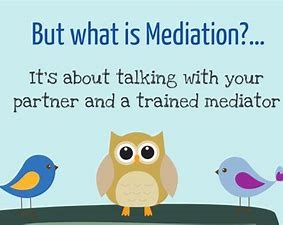What is family mediation?
Family mediation is a way of helping families to reach agreements about what should happen after separation or divorce. It is an increasingly popular alternative to asking the court to make decisions about family issues.
Every day, family mediation helps couples who are in the process of separating or divorcing to decide what to do about the house, the children, the assets, the debts, and can help everyone in the family to establish new working relationships.
In family mediation, you negotiate face to face with your partner about arrangements that need to be made for the future, with the help of one or two neutral third parties – the mediator or mediators.
Is family mediation is a good option for your family
The government and many judges believe that more people should use family mediation to avoid the expense, delays and conflict often associated with going to court.
Family mediation is now an official part of the Family Justice System because most people who want to ask the courts to make a decision about a family issue now have to see an authorised family mediator first, to find out more about family mediation and other alternatives to court. These meetings are called Mediation Information and Assessment Meetings, or MIAMs. If you are not sure whether or not family mediation would be a good option for your family, it is probably a good idea to go to one of these meetings, to talk to a mediator about your personal situation.
Choose a mediation process to suit you
Sole Mediation
After the assessment meetings have taken place, the normal process in this country involves two adult clients meeting with a qualified mediator together in one room, and all three people talking through the issues and the possible solutions together. This process is described in more detail in steps 4-6, but in outline the normal process involves from 1 to 6 sessions, depending on the number of issues that need to be discussed and how complex or difficult the issues are; each session usually lasts between one and a half and two hours. With the client’s agreement the mediator may invite other people into the process if that seems helpful, for example a pensions expert or a family therapist; other professionals invited to take part might attend the mediation sessions, or they might set up separate sessions of their own.
Co-mediation
One of the most common alternatives to sole mediation involves two adult clients meeting with two qualified mediators together in one room, and all four people talking through the issues and the possible solutions together
Shuttle Mediation
Another way of working is to use two rooms. The two adult clients each stay in their own separate room, and the mediator or mediators ‘shuttle’ between them. There is no face to face communication between the clients, so this kind of mediation doesn’t help to develop better communication in the way that other forms of mediation can, but it can be a good way to help clients negotiate safely. Shuttle mediation sessions usually take longer than other mediation sessions.
Direct consultation with children
This is an approach that can be combined with any of the other methods. In it, a child who wants to be involved in the process talks with a specially qualified child consultant mediator. The parents agree in advance that this meeting is confidential between the child and the mediator, and unless any child protection issues arise, the mediator will only tell the parents what the child has agreed should be passed on.
What to expect from mediation
MIAM (Information and Assessment Meeting)
Every mediation will begin with an assessment meeting. Many people have separate assessment meetings some time before the first joint session. Some people prefer to come together to the assessment meeting, with a joint session following straight afterwards if their case is suitable for mediation
Agreement to mediate
At the very beginning of the actual mediation, the mediator will ask you both to sign an agreement to mediate, after checking with both of you that you understand what it says and that you both know how mediation works. The agreement to mediate is a standard document, used by all qualified family mediators, and is something that is required by the Family Mediation Council, which regulates all family mediators. The mediation cannot go ahead unless the agreement to mediate has been signed.
During mediation session
During the mediation your mediator will give you useful information about how to deal with financial issues, how to deal with children issues, relevant legal principles, the court process, court orders, and how to contact other agencies and specialists who may be able to help. The mediator will ask you important questions about what ideas you have about the future, and about what is worrying you about the present. They may even talk a little about what has gone wrong in the past, although the problems of the past are not the main focus of mediation. The mediator will also set the rules he or she expects everyone to follow. These will include speaking and listening to each other with respect, and working with the mediator to make sure that conflict and any strong emotions that emerge during the mediation don’t overwhelm the process.
If the two of you are able to identify some proposals that you think might work, the mediator will record those proposals in a confidential way, for you to turn into a legally binding agreement after getting legal advice.
Your contribution to mediation
After signing the agreement to mediate, you will work with the mediator to:
- Explain your family situation.
- Set the mediation agenda. The mediation sessions are tailored around what you want and need to discuss.
- Agree the issues that you need to discuss.
- Decide the priority of the issues. Some issues are more pressing than others and need to be resolved first, e.g., short-term financial arrangements, holidays, contact.
- Set time scales to deal with certain matters e.g., for separation or divorce.
- Clarify the issues: sometimes it is not certain what is really in dispute and clarifying the issues avoids misunderstandings.
- Consider whether any other specialists might be able to help you.
- Find the common ground.
- Provide/obtain information, e.g., complete a financial questionnaire or have a form explained to you. If you have financial issues to discuss, it is particularly important to make sure everyone has a very clear picture of the family’s financial situation. This involves each of you providing details about any property you own, and your income and expenditure, very much as you have to if you go to court.
- Look at the various options and reality test those options. When there are financial issues you will need to give consideration to what everyone in the family needs, especially the children.
- Arrive at the option that best suits both of you and work out the details of your proposals.
The end of the mediation process
At the end of the mediation process your mediator will explain to you how to obtain legal advice about any proposals the two of you have produced together and how you may convert them into a legally binding agreement and/or a court order. Proposals relating to children often do not need to be turned into a court order, but proposals relating to finances almost always should be. If you have not been able to find any mutually acceptable proposals, your mediator will explain to you what your options are at this stage, including negotiation through other means, arbitration and court proceedings. Although the mediator will never instruct you to do something, they may suggest that you take further advice, for example that you consult with a tax or pensions specialist, or with a family lawyer, before making any decisions.
Even where mediation does not succeed, it may be able to help by giving you a better idea of what your family’s real issues and options are, and by giving each of you an opportunity to hear directly from the other person involved.
.


